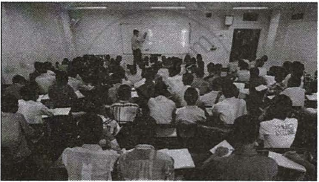Advertisements
Advertisements
प्रश्न
23 spoons and 17 forks cost Rs.1770, while 17 spoons and 23 forks cost Rs.1830. Find the cost of each spoon and that of a fork.
उत्तर
Let the cost of a spoon be Rs.x and that of a fork be Rs.y. Then
23x + 17y = 1770 ……….(i)
17x + 23y = 1830 ………(ii)
Adding (i) and (ii), we get
40x + 40y = 3600
⇒ x + y = 90 ………..(iii)
Now, subtracting (ii) from (i), we get
6x – 6y = -60
⇒ x – y = -10 ………..(iv)
Adding (iii) and (iv), we get
2x = 80 ⇒ x = 40
Substituting x = 40 in (iii), we get
40 + y = 90 ⇒ y = 50
Hence, the cost of a spoon that of a fork is Rs.40 and Rs.50 respectively.
APPEARS IN
संबंधित प्रश्न
Find the values of p and q for which the following system of linear equations has infinite a number of solutions:
2x - 3y = 9
(p + q)x + (2p - q)y = 3(p + q + 1)
Find the value of k for which the system of equations has a unique solution:
4x + ky + 8=0,
x + y + 1 = 0.
Find the value of k for which the system of linear equations has an infinite number of solutions:
(k – 1)x – y = 5,
(k + 1)x + (1 – k)y = (3k + 1).
Find the values of a and b for which the system of linear equations has an infinite number of solutions:
(2a – 1) x + 3y = 5, 3x + (b – 1)y = 2.
Find the values of a and b for which the system of linear equations has an infinite number of solutions:
2x + 3y = 7, (a + b + 1)x - (a + 2b + 2)y = 4(a + b) + 1.
The cost of 5 pens and 8 pencils together cost Rs. 120 while 8 pens and 5 pencils together cost Rs. 153. Find the cost of a 1 pen and that of a 1pencil.
Find the value of k for which the system of equations 2x + 3y -5 = 0 and 4x + ky – 10 = 0 has infinite number of solutions.
Solve for x:
Find the value(s) of p in (i) to (iv) and p and q in (v) for the following pair of equations:
– 3x + 5y = 7 and 2px – 3y = 1,
if the lines represented by these equations are intersecting at a unique point.
Read the following passage:
|
A coaching institute of Mathematics conducts classes in two batches I and II and fees for rich and poor children are different. In batch I, there are 20 poor and 5 rich children, whereas in batch II, there are 5 poor and 25 rich children. The total monthly collection of fees from batch I is ₹9,000 and from batch II is ₹26,000. Assume that each poor child pays ₹x per month and each rich child pays ₹y per month.
|
Based on the above information, answer the following questions:
- Represent the information given above in terms of x and y.
- Find the monthly fee paid by a poor child.
OR
Find the difference in the monthly fee paid by a poor child and a rich child. - If there are 10 poor and 20 rich children in batch II, what is the total monthly collection of fees from batch II?

